|
|
有趣的church sign。。。 XD XD (51楼)
[复制链接]
|
|
|

楼主 |
发表于 26-10-2007 11:42 PM
|
显示全部楼层
通過基督教在埃塞俄比亞日期至第四世紀統治的aksumite皇帝ezana 。aksum的地理位置,在最南端邊緣的hellenized近東,是至關重要的,其轉化率和發展。王國位於沿主要的國際貿易路線,通過紅海之間,印度和羅馬帝國。故事ezana的轉換已改由幾個現有的文件,該教會的歷史rufinus與蘇格拉底scholasticus。雙方重新計如何弗魯門齊烏斯,一個青年從輪胎,是船難並送往法院aksum。弗魯門齊烏斯找了基督教的羅馬商人,改建,並在後來成為第一個主教aksum 。在最低限度,這個故事表明,基督教被帶到aksum途經商人。ezana的決定採納基督教是最有可能影響他的願望,鞏固貿易關係,與羅馬帝國。基督教提供了可能性,凝聚許多不同種族和語言的人民的aksumite英國,一個目標ezana的領導。aksum是國內最早國制定一項錢幣體系,以服務,其先進繁榮的經濟。皇帝ezana是第一次世界領導人把兩岸關係上的硬幣是最早的例子基督教物質文化來自埃塞俄比亞。
依然是獨特的aksumite教堂建築已設在aksum ,斯里蘭卡和adulis。這些都是面向basilicas同加強podia,這是進入的一個巨大的樓梯。這些教會包括apse側廣場大樓,引入到設計basilicas沿南部海岸的小亞細亞,敘利亞和巴勒斯坦,由五世紀。興建教堂,是相信已成功服務於宗教的需要,新的行政和軍事官員聚居在擴大領土。成長的aksumite狀態結束後,波斯征服南阿拉伯,而流離失所的貿易路線的紅海。
而其來源不明的情況下,該扎格威王朝出現了一段時間,在此期間減少的財富和國際威望,並有可能持續到1270年。幾乎完全缺乏尚存的手稿,所以很難得到一個明確的了解該時期。後放棄aksum ,過去的政治和經濟資本,這個城市的羅哈,現在稱為lalibela,確立為禮儀中心的扎格威王朝。教會最有可能基於aksumite先例hewn出搖滾生活在山區的lasta。教會的救贖主,最大的可能也是最有名的教堂lalibela ,可能是一個建築副本大教堂佑的錫安在aksum。在內飾件的這些宏偉建築物佈滿繪畫和壁畫。
yekunnoamlak的推翻執政扎格威王朝1270年標誌著早期solomonic期間( 1270年至1530年) 。amlak根據他的要求,以對合法性的指控系與古代統治者aksum原產於與所羅門王和王后的sheba。這一時期是一個巨大的社會和文化變革與發展。廣泛的國際貿易回埃塞俄比亞以來,歐洲人尋找替代品交易一直伊斯蘭控制的路線。這死灰復燃持續到葡萄牙四捨五入的好望角。招來傳說中的所羅門王,統治者這一時期成立的皇家教堂大派飾有壁畫,黃金裝飾品,和珍貴織物。這些措施包括著名搖滾-hewn教會特格雷和lasta。通過背景與寺院的領袖,這些世俗統治者用藝術的乘客,其中包括招募歐洲工匠精神,樹立他們的權威和提高他們的威信。這個界面與歐洲暴露埃塞俄比亞藝術家,以新的媒介,技術和美學情面。這些影響都反映在壁畫,通過轉變,從剛性frontality和廣泛使用的幾何圖案,以三個季度的姿態,更大的流動路線,並利用模型來描述三維立體數字。這種新的風格包含兩個拜占庭和意大利的原型。
寺院,例如德布拉hayqestifanos修道院阿姆哈拉,被確立為中心的學習。這些複合物通常包含廣泛scriptoria為不平凡的照明手稿,其中很少有生存的空間。勞力密集的工作,該scriptorium是往往被認為是一個關鍵層面出家的精神訓練。有許多寺廟在該地區的湖泊塔娜,包括對fré seyon,其中兩個有名的藝術家這一時期。seyon貸記與發展的devotional瑪麗安圖標形象和風格。瑪麗成了一個極其重要的人物,埃塞俄比亞教會當皇帝zar'a ya'eqob (r. 1434年至1468年)的任務是閱讀的奇蹟,聖母瑪利亞和她兌現,最多的30天盛宴,在禮儀一年。 zar'aya'eqob尤其是成功地運用權力,她的視覺意象,以公開強調教誨,她的中心位置,以基督教的救恩。
伊斯蘭jihads的1531年通過第1543由周邊國家的阿達爾摧毀了許多皇家教堂,圖書館和寺院,因而喪失了他們的所有記錄。罕見的例子非凡皇家乘客的早期solomonic時期倖存下來的被保存在非常偏僻,交通不便的寺廟。長時間的混亂之後adalite入侵,其中包括後來的入侵進取的團體尋求以填補權力真空留下秋天的aksumites 。在17世紀,大大減少基督教帝國,建立了新的資本gondar 。直到其攻擊提格雷在1769年,gondar是精神的,藝術的,和政治中心的帝國,因此是一個站點為原則scriptoria和畫家工作坊,以及建築設計創新。
而早前aksumite教堂被通知,後來建設的故意企圖模仿者的描述所羅門王的廟宇,在舊約。該教堂建於gondar有一個廣場避難所與兩個過道沿周邊。現正在進行內部完全涵蓋在這兩個壁畫和繪畫被委託的富人精英,以協助他們阿森松天堂。這是一個時期的緊張藝術生產,其中包括,尤其是,有相當數量的圖標專門討論聖母瑪麗亞顯靈。
埃塞俄比亞皇室王朝依然完好無損,直到推翻在1974年的海爾塞拉西,最後基督教皇帝,由軍事政變。 |
|
|
|
|
|
|
|
|
|
|
|

楼主 |
发表于 26-10-2007 11:45 PM
|
显示全部楼层
Eastern and Southern Africa, 1000–1400 a.d.
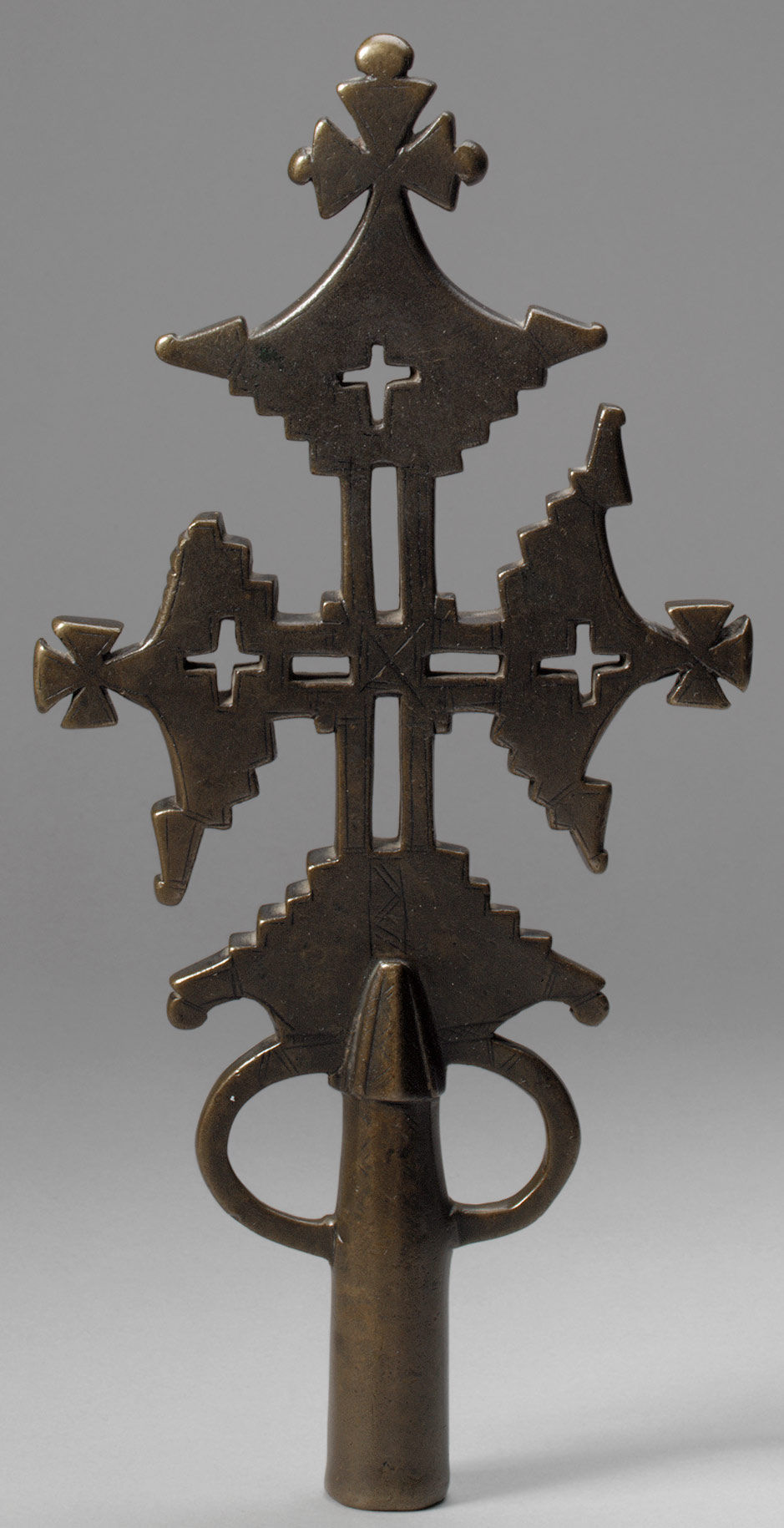
Processional Cross, 14th–15th century, before 1400 (?)
Ethiopia, Lalibela
Brass (cast); H. 10 1/2 in. (26.7 cm)
Thehistory of Christianity in Ethiopia is longstanding, dating back to thefourth century A.D. At that time, King Ezana, ruler of Aksum, made itthe court religion. In spite of the antiquity of Ethiopian Christianart, however, processional crosses antedating the seventeenth centuryare rare due to sixteenth-century Islamic incursions that devastatedthe region.
Crosses such as thiswere commonly given to important monasteries by Ethiopian monarchs; inreturn, the clergy would remember the donors in prayers. Like manyearly Ethiopian crosses, this one was cast in brass using the lost-waxmethod. Since lost-wax objects must be made individually and arenecessarily unique, this casting technique may have encouraged theexperimentation that has yielded a spectacular diversity of Ethiopianmetal crosses.
This processionalcross has short side arms and longer vertical arms, features it shareswith related Coptic and Byzantine traditions. Later crosses wouldequalize the length of the arms and fill in the gaps between them,almost dissolving the cross form into a diamond shape that waspunctuated with interlacing patterns. The beginnings of the lattertendency can be seen here, particularly in the negative spaces thatreplicate the cross form at its three terminal points and therectangular openings within its arms. Openings like these were bothpractical and aesthetic; they allowed crosses to be made larger withoutadded weight, and when used in processions made impressive silhouettesagainst the open sky. At the base of the metal cross, just above itspoint of attachment to a long staff (no longer extant), are a pair ofloops that served an additional purpose. These would have provided aplace to affix the colored cloths that trailed from processionalcrosses while they were in use. A subtle counterpoint to these openspaces, shallow engraved lines thinly trace the stepped shape of thecross and enliven its broad planes with geometric patterns.
Until more recenttimes, Ethiopian processional crosses favored abstract openworkpatterns and images of the Virgin and Child above the depiction of theCrucifixion scene. In part this reflects the view of the EthiopianOrthodox Church, which does not see the cross solely in terms ofChrist's Passion but also as the "Tree of Life in the midst of theGarden" (Genesis 2:9) and a vehicle of God's blessing to man.
Processional crossesplay an active role in Christian religious life in Ethiopia, wherechurches commonly have one or more. They are prominently featuredduring services and processions that honor holy days such as theEpiphany or the feast of the Finding of the True Cross. Held aloft byclergy wearing ceremonial attire and accompanied by colorful umbrellas,these crosses imbue sacred occasions with reverential majesty.
歷史上基督教在埃塞俄比亞源遠流長,可追溯至四世紀交替那個時候,國王ezana ,統治者aksum ,使得法院的宗教。儘管如此,古物埃塞俄比亞基督教藝術,不過, processional十字架所填十七世紀,是難得的是由於16世紀伊斯蘭入侵破壞該地區。
十字架等,這被普遍給予重要寺院,由埃塞俄比亞的君主;作為回報,該法案將破壞記得捐助者祈禱。像許多早期埃塞俄比亞十字架,這是一個演員在黃銅採用失蠟法。自失蠟對象必須作出單獨和必然是獨一無二的,這種鑄造工藝可能鼓勵試點,已經取得了一項別開生面的多樣性埃塞俄比亞金屬十字架。
這processional兩岸已是偏緊的武器和較長的垂直武器,它的特徵與股票有關的科普特和拜占庭傳統。後來十字架會均等的長短武器,填補空白之時,幾乎解散交叉形成一個鑽石形狀,這是連續性與交織圖案。開始的,後者的趨勢,可以看出,在這裡,特別是在負位複製的交叉形式,在其三個終端點和矩形開口其武器。開口想這些都是實用與美感;它們允許十字架,以取得較大的,沒有補充,體重,並使用時,在遊行取得了令人印象深刻的silhouettes對開放天空。在該基地的金屬交叉,僅略高於其出發點附著到一個長期的工作人員(不再現存),是一個雙迴路即送達的另一個目的。這將提供一個地方,要追究有關有色布說,跟踪從processional十字架,而他們在使用。一個微妙的counterpoint這些開放空間,淺刻有薄線追查加強橫截面形狀和盤活其廣泛的飛機與幾何圖案。
直到最近,埃塞俄比亞processional十字架最惠國待遇摘要openwork模式和圖像,維爾京和兒童以上描寫的十字架現場。在這一部分體現了這一觀點的埃塞俄比亞東正教教堂,其中不看兩岸純粹從基督的激情,而且作為"生命樹在一片花園" (成因2時09分)和一輛汽車上帝的祝福的人。
processional十字架發揮積極作用,在基督教的宗教生活在埃塞俄比亞,而教會普遍有一個或一個以上。他們突出特色,在服務和遊行的榮譽神聖的日子,如頓悟還是盛宴的找到真正的交叉。高舉由神職人員穿著禮儀服飾伴隨著五彩繽紛的雨傘,這些十字架貫穿於神聖的場合與reverential陛下。 |
|
|
|
|
|
|
|
|
|
|
|

楼主 |
发表于 26-10-2007 11:49 PM
|
显示全部楼层
Eastern and Southern Africa, 1000–1400 a.d.
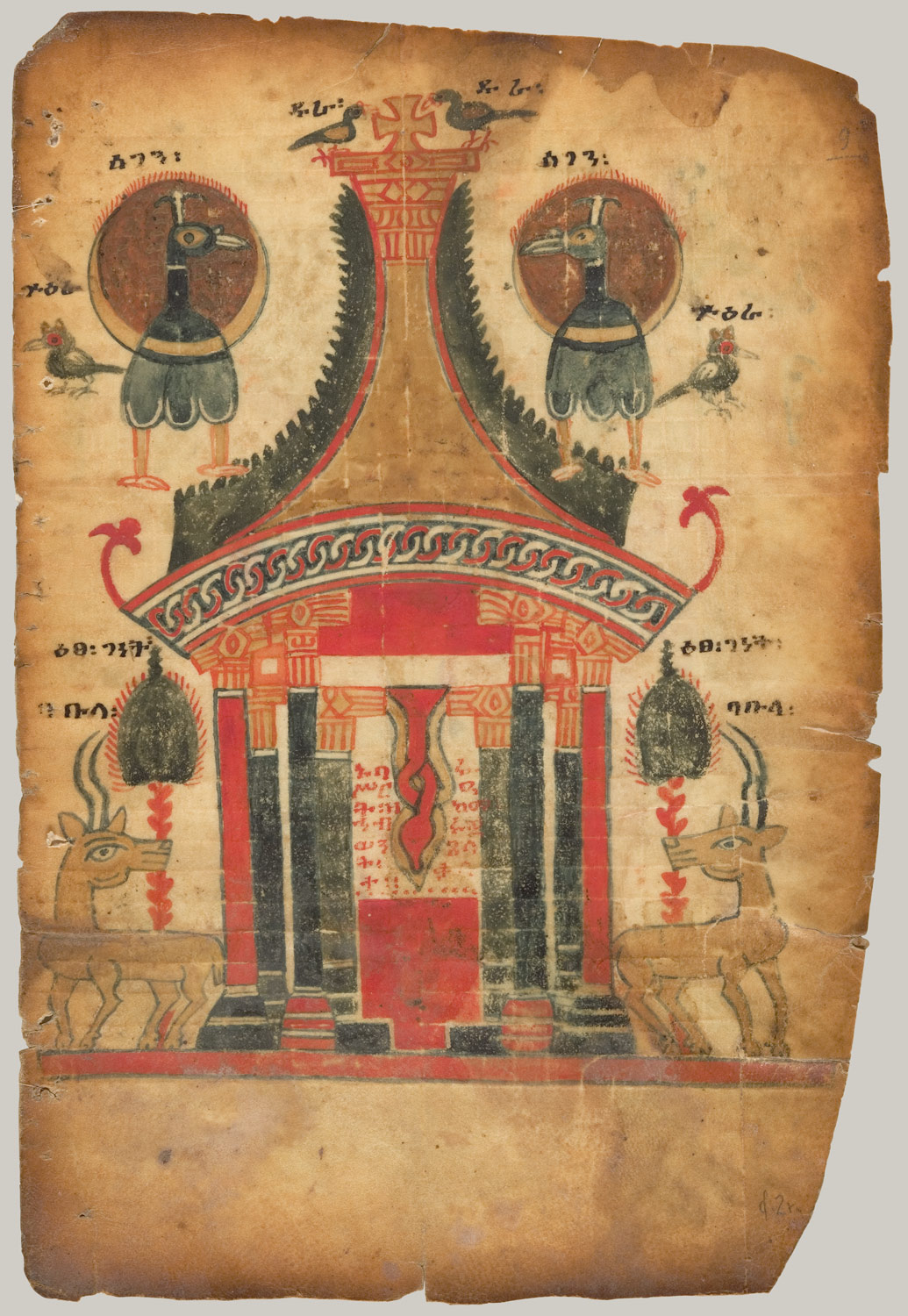
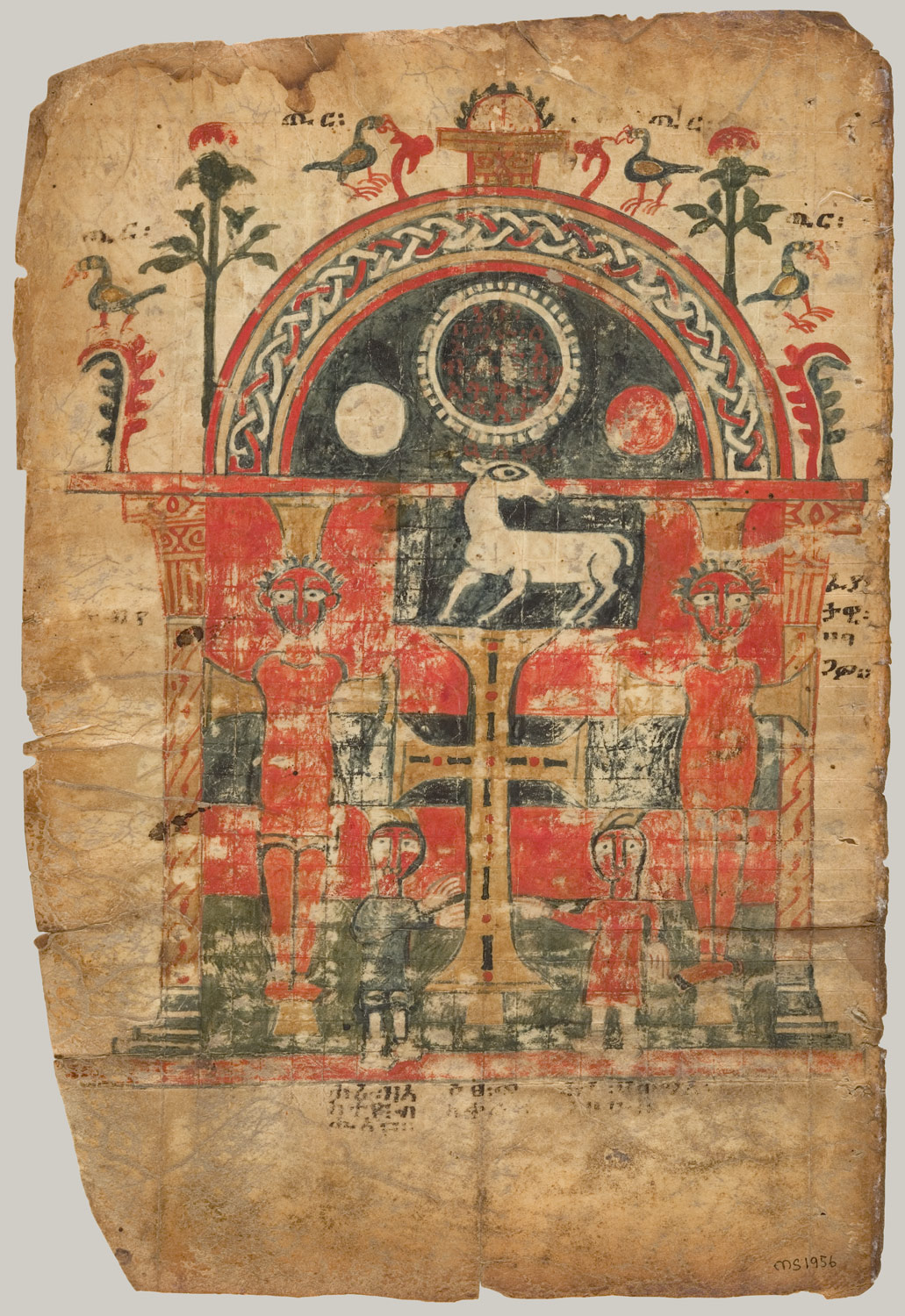
Double-Sided Gospel Leaf, first half of 14th century
Ethiopia; Tigray region
Tempera on parchment; 11 x 7 1/2 in. (27.8 x 19 cm)
Purchase, Oscar de la Renta Ltd. Gift, 2005 (2006.100)
TheTigray region of Ethiopia converted to Christianity in the fourthcentury and became a very important ally of the Byzantine empire, ruledfrom Constantinople (Istanbul), in controlling the trade routes toIndia. Tigray also maintained contacts with other Christian communitiesof the eastern Mediterranean, including those in Syria and Egypt. Thecompelling images on this double-sided leaf are from a group of earlyfourteenth-century Gospels that feature a revival of motifs thatreached Ethiopia from the eastern Mediterranean, probably in theseventh century.
Both sides of the leaf are inscribed in Ge'ez, the ancient languageof Ethiopia. On the front is a dramatic octagonal Fountain of Lifeflanked by peacocks, which are identified in the inscriptions as"ostriches" (royal birds in Ethiopia), and gazellelike "babula." Thetext within the domed space refers to the arrangement of the EusebianCanon Tables, or index to the Gospels, which preceded the image in theoriginal manuscript. On the reverse, the Crucifixion is represented bya monumental jeweled cross topped by a Lamb of God, symbol of Christ'ssacrifice. At the sides are the two thieves bound to their crosses.Other leaves from this Gospel are in the National museum in Stockholm.
提格雷地區的埃塞俄比亞皈依基督教在四世紀時,成為一個非常重要的盟友,拜占庭帝國統治,從君士坦丁堡(伊斯坦布爾),在控制其貿易路線,以印度。提格雷還保持著聯繫,與其他基督信仰團體的東地中海地區,包括那些在敘利亞和埃及。令人信服的圖像,這雙面葉是從一組早在第十四世紀福音那種功能復甦的圖案達到埃塞俄比亞從地中海東部,有可能是在公元7世紀。
雙方的葉片是銘刻在ge'ez,古代語言的埃塞俄比亞。在前面是一個巨大的八角型噴泉的生活,兩旁是孔雀,這是確定的題字為"鴕鳥" (英國皇家鳥類在埃塞俄比亞),並gazellelike"鮑布洛"文內圓頂空間,是指以安排的eusebian佳能桌,或索引,以福音書,其中前面的形象在原稿。就反過來,在十字架上都代表了一個不朽的寶石交叉突破,由羔羊的上帝,象徵基督的犧牲。在兩岸是兩個小偷約束自己的十字架。其他樹葉從這個福音,是在國家博物館在斯德哥爾摩。
|
|
|
|
|
|
|
|
|
|
|
|

楼主 |
发表于 26-10-2007 11:51 PM
|
显示全部楼层
Eastern and Southern Africa, 1000–1400 a.d.
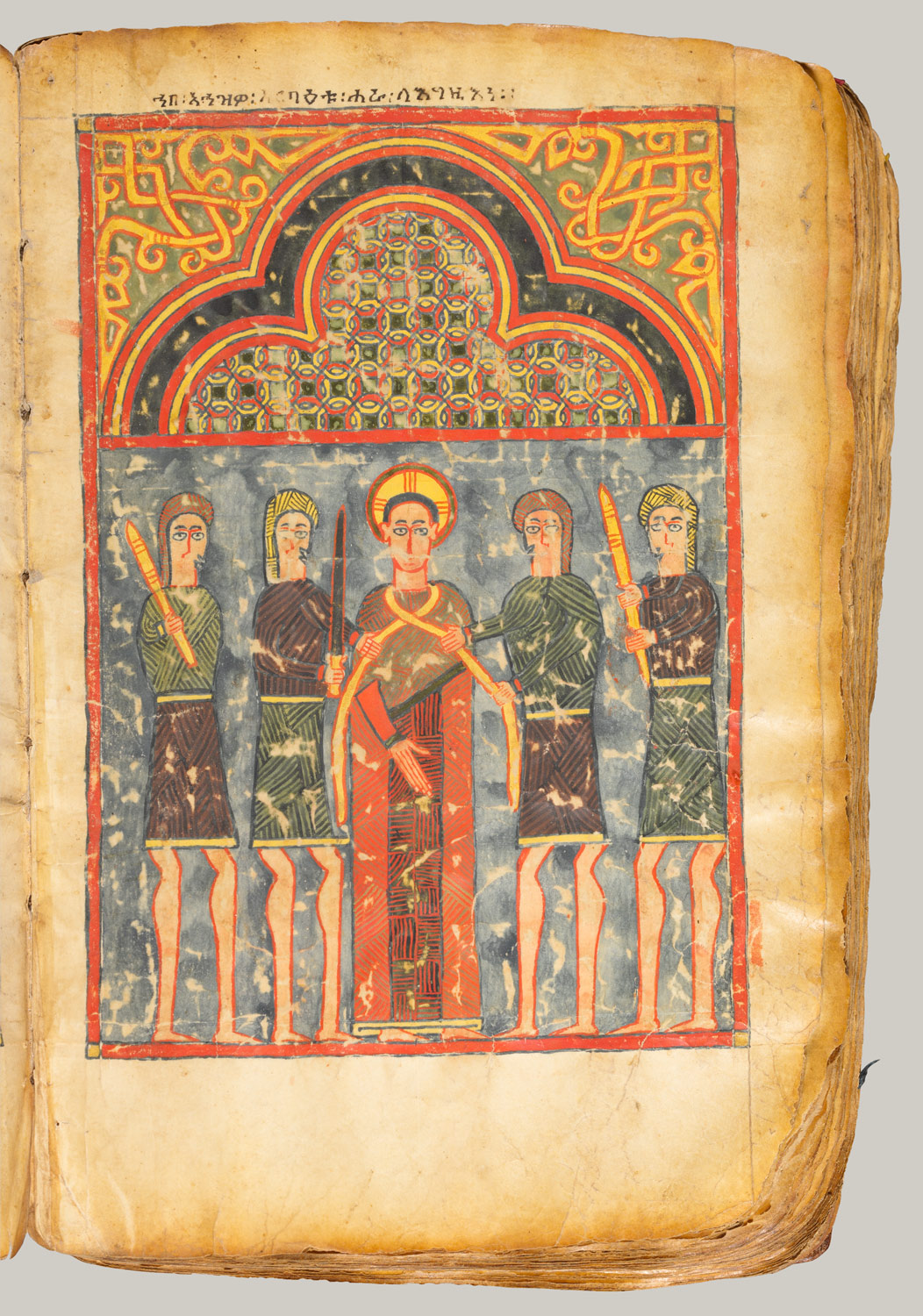 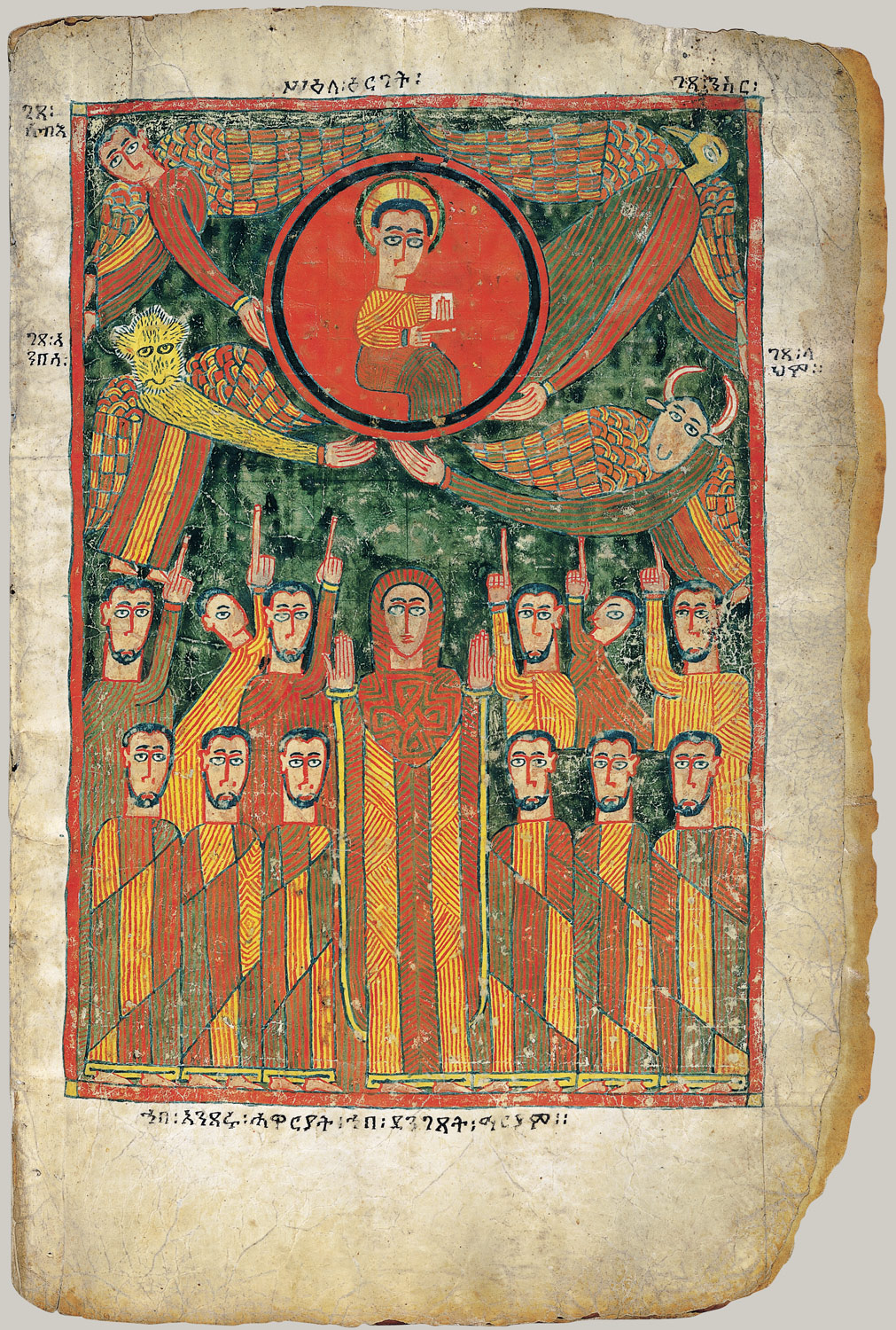
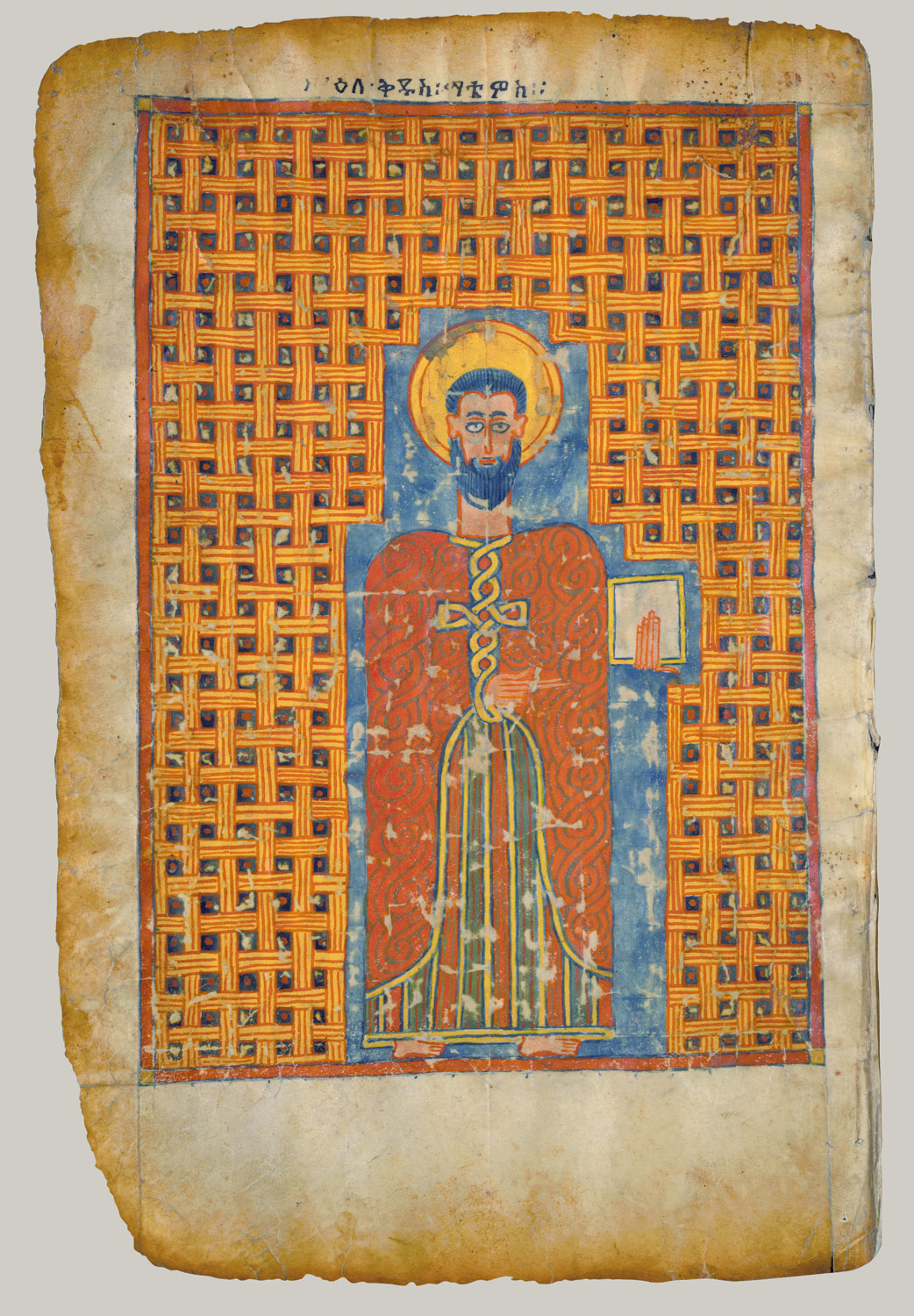
Page from an Illuminated Gospel, late 14th–early 15th century
Ethiopia, Amhara region
Wood, vellum, pigment; H. 16 1/2 in. (41.9 cm)
Rogers Fund, 1998 (1998.66)
Thisilluminated manuscript of the Four Gospels was created in the latefourteenth to early fifteenth century at a monastic center in theAmhara region of Ethiopia. Its full-page paintings on vellum depict NewTestament scenes from the life of Christ and portraits of theevangelists. The text is in Ge'ez, the classical Ethiopian language.Typical of Ethiopian painting, the imagery is two-dimensional andlinear. Heads are seen frontally; bodies are often in profile. Theartist abbreviated the facial features and treated the human form as acolumnar mass, articulated in bold black and red lines.
The Four Gospels are the essence of Ethiopian Christianity. Thismanuscript was likely kissed, displayed during processions, and placedon the altar to mark important events on the church calendar, such asfeasts or holy days. Recent research suggests that a member ofEthiopia's ruling elite may have commissioned this manuscript of DabraHayg Estifanos monastery for presentation to his or her favored churchor monastery. Brief notations indicate that the church in question wasdedicated to the Archangel Michael.
In the fourth century A.D., the Ethiopian king Ezana converted toChristianity. Christianity became the official religion of the statewhose legacy endured in various forms until the twentieth century.Around the time this manuscript was made, Ethiopia's Christian kingdomexpanded its influence. Monastic centers became increasingly importantoutposts of state power. They were also the chief sites of Christianart production. During the sixteenth century, Islamic incursionsdevastated the region, and most Christian Ethiopian art that predatesthe seventeenth century was destroyed. This illuminated gospel is arare survival.
這發亮手稿的四大福音書是在14月底到15月初世紀的一個寺院的中心,在阿姆哈拉地區的埃塞俄比亞。它以整版篇幅繪畫vellum描繪新約聖經的情景,從生活中的基督畫像的evangelists 。該文是在ge'ez,古典埃塞俄比亞的語言。屬於典型的埃塞俄比亞繪畫,意象是兩維和線性。校長看到正面;機構往往在剖面上。藝術家簡稱面部特徵和治療人類作為一個柱狀腫塊,闡述了大膽的黑色和紅色的線。
4個福音,是本質的埃塞俄比亞基督教。這個手稿可能是吻,展現在遊行時,並放置在神龕,以紀念重要事件,對教會年曆,如宴或神聖的日子。最近的研究表明,成員埃塞俄比亞的統治精英可能已委託本手稿的德布拉haygestifanos寺,以便提交給他或她的青睞教堂或修道院。簡短的批註表明,該教堂的問題,是獻給的archangel邁克爾。
在第四世紀公元,埃塞俄比亞國王ezana皈依基督教。基督教成為官方宗教的國家,其遺產,在經歷了各種形式的,直到20世紀。圍繞本書稿寫了,埃塞俄比亞的基督教王國擴大其影響力。寺院的中心變得越來越重要前哨國家政權。他們還政務網站的基督教藝術生產。在16世紀,伊斯蘭入侵蹂躪地區,其中大部分基督教的埃塞俄比亞藝術早在17世紀被摧毀。這發亮福音,是一個難得的生存。 |
|
|
|
|
|
|
|
|
|
|
|

楼主 |
发表于 26-10-2007 11:52 PM
|
显示全部楼层
Eastern and Southern Africa, 1400–1600 a.d.
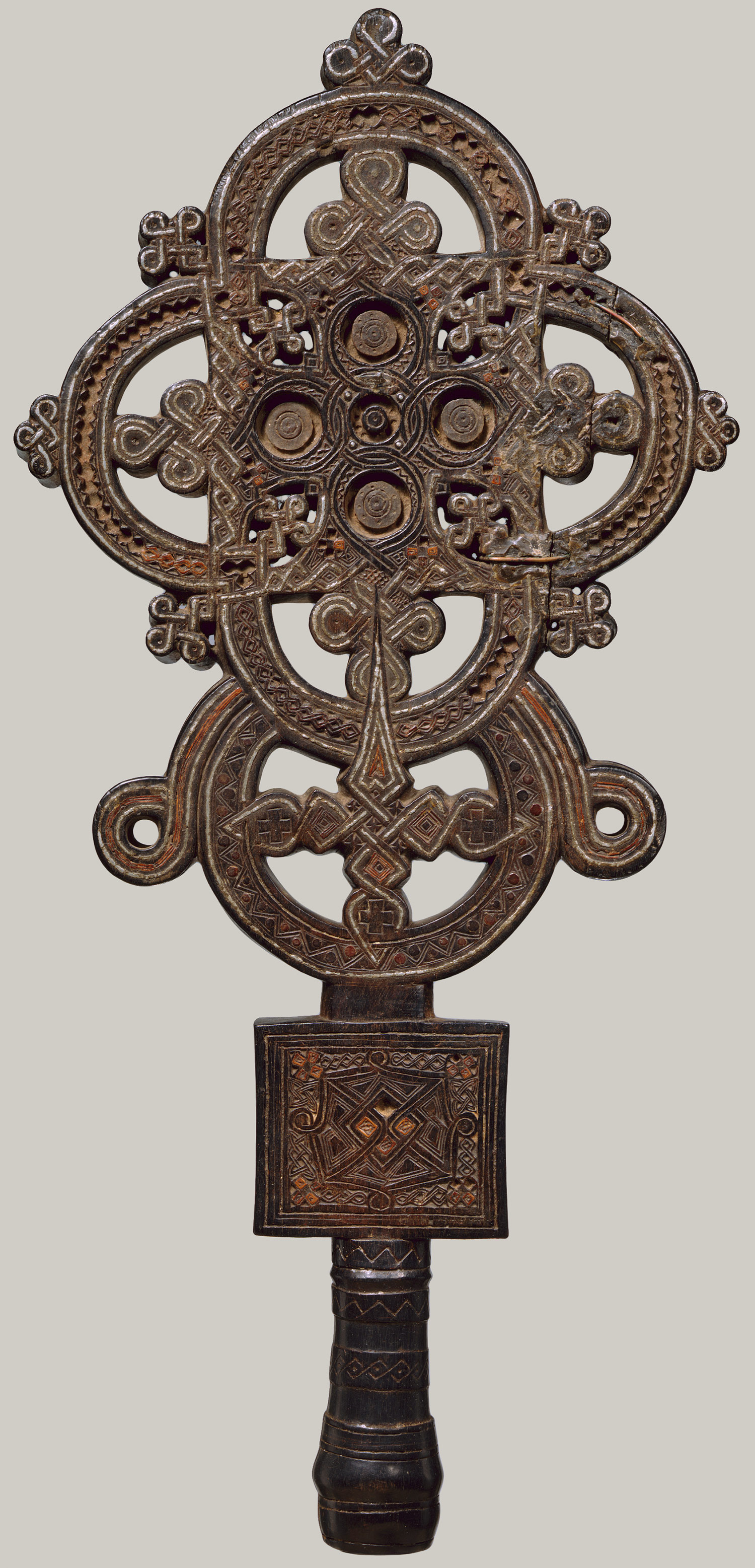
Processional Cross, 16th century (ca. 1500)
Ethiopia, Tigray region; Amharic
Wood, tin; H. 18 x W. 8 1/2 in. (45.7 x 21.6 cm)
Rogers Fund, 1999 (1999.103)
Thiscross was created in the province of Tigray, near the Red Sea, thebirthplace of Ethiopia's earliest kingdom and of Christianity inAfrica. Works in wood are especially rare within the relatively smallcorpus of Ethiopian Christian art predating the seventeenth century.The majority of earlier Ethiopian processional crosses that havesurvived are cast in bronze or silver.
Underlying this exceptional object's aesthetic is a technicallyaccomplished fusion of wood sculpture and metalwork inspired byByzantine and Islamic design. The highly unusual interplay of materialsaffords rich tonal contrasts and skillfully integrates the solidity ofthe carved wooden structure with the finely inscribed inlays. Thelinear accent of the metallic threads at once lightens the density ofthe wooden structure and highlights the intricacy of the work's designelements.
In the Ethiopian church, the wooden cross is perceived as havingbeen sanctified by Christ's blood, which conferred upon it infinitepower to heal and to bless. Foliate and organic interlace designs,branching from the foot of the cross, are interpreted as symbolizingthe Tree of Paradise, and thus a vibrant life-giving force.Commissioned by Ethiopian royalty, such works were presented toimportant monasteries to be carried in liturgical processions.
這是兩岸關係創造了在該省的提格雷,靠近紅海的發祥地,埃塞俄比亞最早的英國和基督教在非洲。工程木材尤其難得的內部比較小的語料庫埃塞俄比亞基督教藝術早於十七世紀。大多數早些時候,埃塞俄比亞processional十字架已經成活是由青銅鑄造,塑像或銀。
背後的這個特殊對象的審美是一種技術上的成就融合的木雕和金工靈感來自拜占庭和伊斯蘭設計。極不尋常的相互作用材料也頗豐富,色調對比和巧妙地結合了堅固的刻木結構與細刻有嵌體。線性口音的金屬線程一下子淡化了密度的木製結構,並突出了錯綜複雜的工作的設計元素。
在埃塞俄比亞教會,木製十字架被視為具有被神聖化,由基督的血,而賦予它的法力無邊的癒合和保佑。莖葉和有機交織設計,分支從腳下過,是解釋為象徵著樹的天堂,因此,一個充滿活力的生命賦予的力量。委託埃塞俄比亞版稅,這些工程被提交給重要的寺廟,以進行在禮儀遊行活動。
[ 本帖最后由 daimon 于 26-10-2007 11:55 PM 编辑 ] |
|
|
|
|
|
|
|
|
|
|
|

楼主 |
发表于 26-10-2007 11:55 PM
|
显示全部楼层
Eastern Africa, 1600–1800 a.d.

Ewost'atéwos and Eight Disciples, late 17th century
Ethiopia
Wood, tempera; H. 22 in. (56 cm)
Louis V. Bell Fund, 2006 (2006.98)
Thishighly original icon is a tribute to the revered Ethiopian visionaryEwost'atéwos, who was born about 1273. The House of Ewost'atéwos is oneof the two major monastic orders of the Ethiopian Orthodox Church.Ethiopia's earliest state adopted Christianity as its official religionin the fourth century. During the next two centuries, foreignmissionaries disseminated Christianity beyond Ethiopia's elite circlesand founded monastic centers in the remote northern regions of Ethiopiaand Eritrea. The abbots of those centers became the chief figures inthe church's local hierarchy. In the fourteenth century, SaintEwost'atéwos founded several more monasteries in northern Ethiopiabefore violent doctrinal disputes led to his exile to Egypt and thenArmenia, where he died.
The eight acolytes surrounding Ewost'atéwos are depicted tounderscore their devotion and allegiance. Only the vibrant, swirlingpatterns of their colorful robes animate and distinguish the otherwiseidentical figures. The painting's considerable scale suggests that itwas the property of a monastery, whose historical origins and ties toneighboring communities it recorded. According to Jacques Mercier, anauthority on Ethiopian culture, this is the only known icon fromnorthern Ethiopia dedicated to a monastic genealogy.
這種高度的原圖標是一個致敬向崇敬的埃塞俄比亞有遠見ewost'atéwos,她生於1273年左右。眾議院ewost'atéwos就是其中的兩大寺院的命令埃塞俄比亞東正教。埃塞俄比亞最早的國家採用基督教作為官方宗教,在第四世紀。在接下來的兩個世紀,外國傳教士傳播基督教超越了埃塞俄比亞的精英界創立了寺院的中心,在偏遠北部地區,埃塞俄比亞和厄立特里亞。該方丈都很這些中心成為行政數字,在教會中的局部層次。在14世紀,聖ewost'atéwos成立幾個寺廟,在埃塞俄比亞北部前暴力教義爭端導致了他的流亡埃及,然後在亞美尼亞,在那裡他死亡。
八個追隨者周邊ewost'atéwos描述,以強調他們的奉獻和忠誠度。只有充滿活力,旋轉模式,他們豐富多彩的長袍,動畫和區分,否則相同的數字。畫中的相當大的規模,表明它是財產的一個修道院,其歷史淵源與聯繫,向周邊社區,它記錄在案。據雅克mercier ,一位權威人士對埃塞俄比亞的文化,這是唯一已知的圖標,從埃塞俄比亞北部專門到一個寺院的族譜。 |
|
|
|
|
|
|
|
|
|
|
|

楼主 |
发表于 27-10-2007 02:45 PM
|
显示全部楼层
Eastern Africa, 1600–1800 a.d.
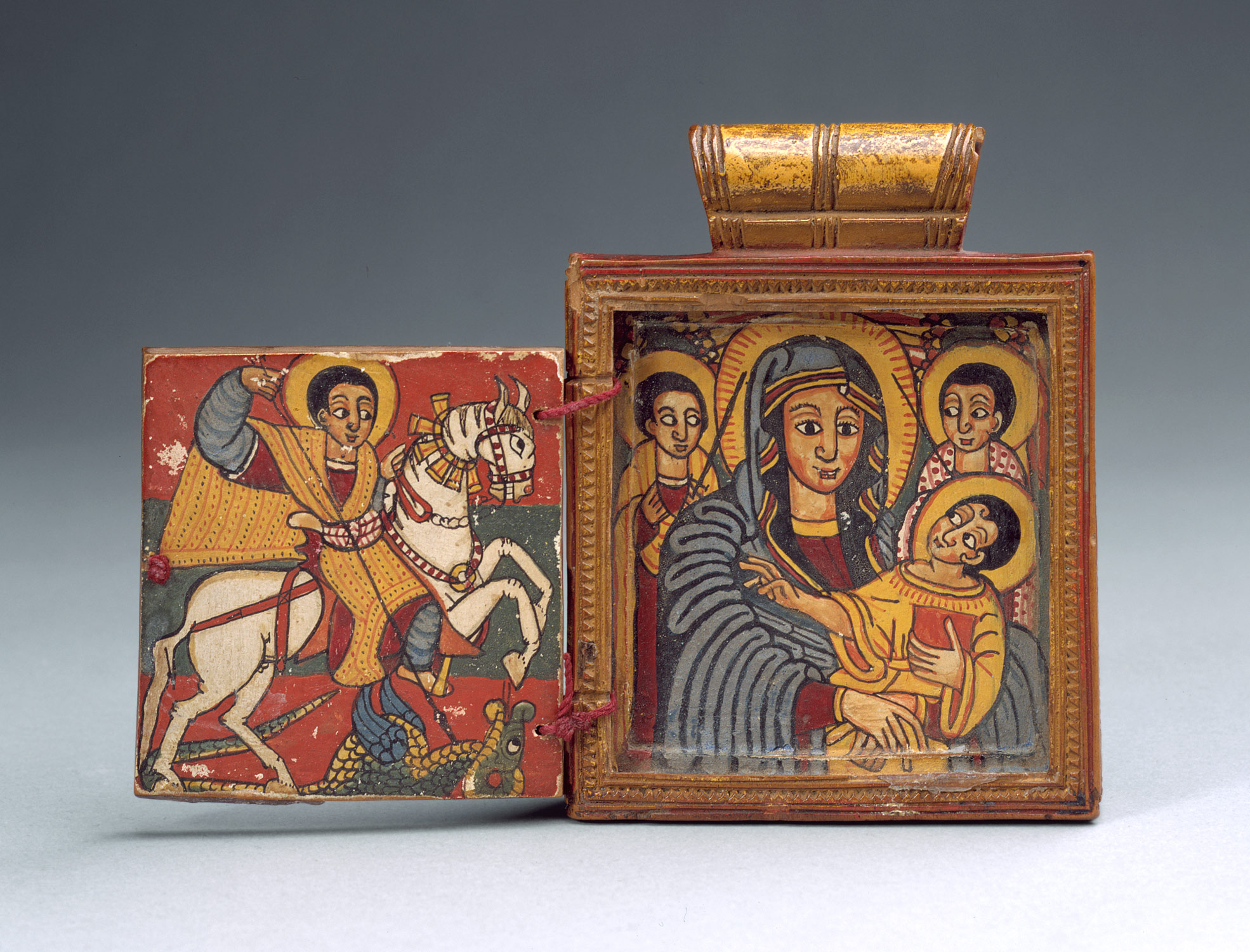
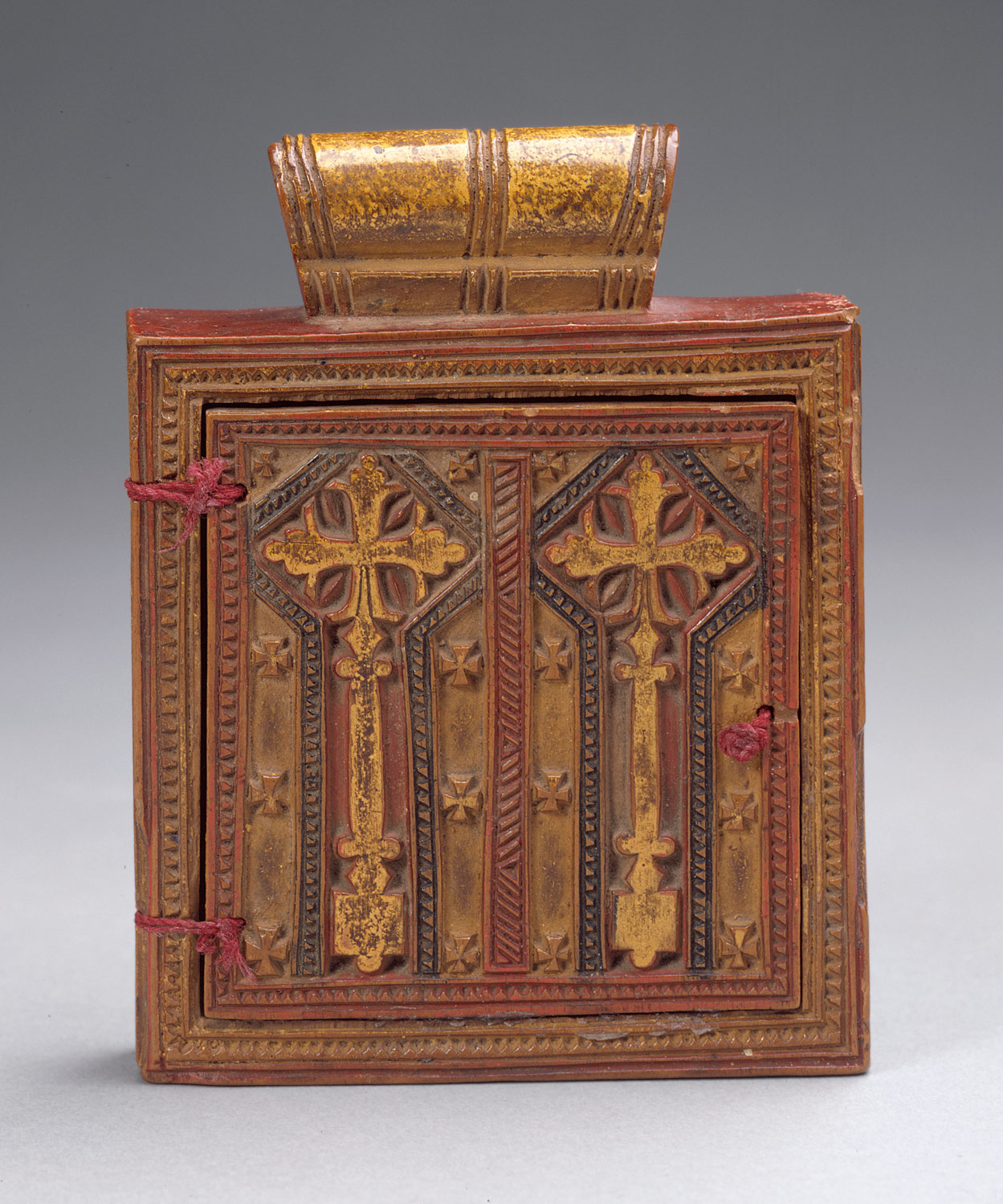
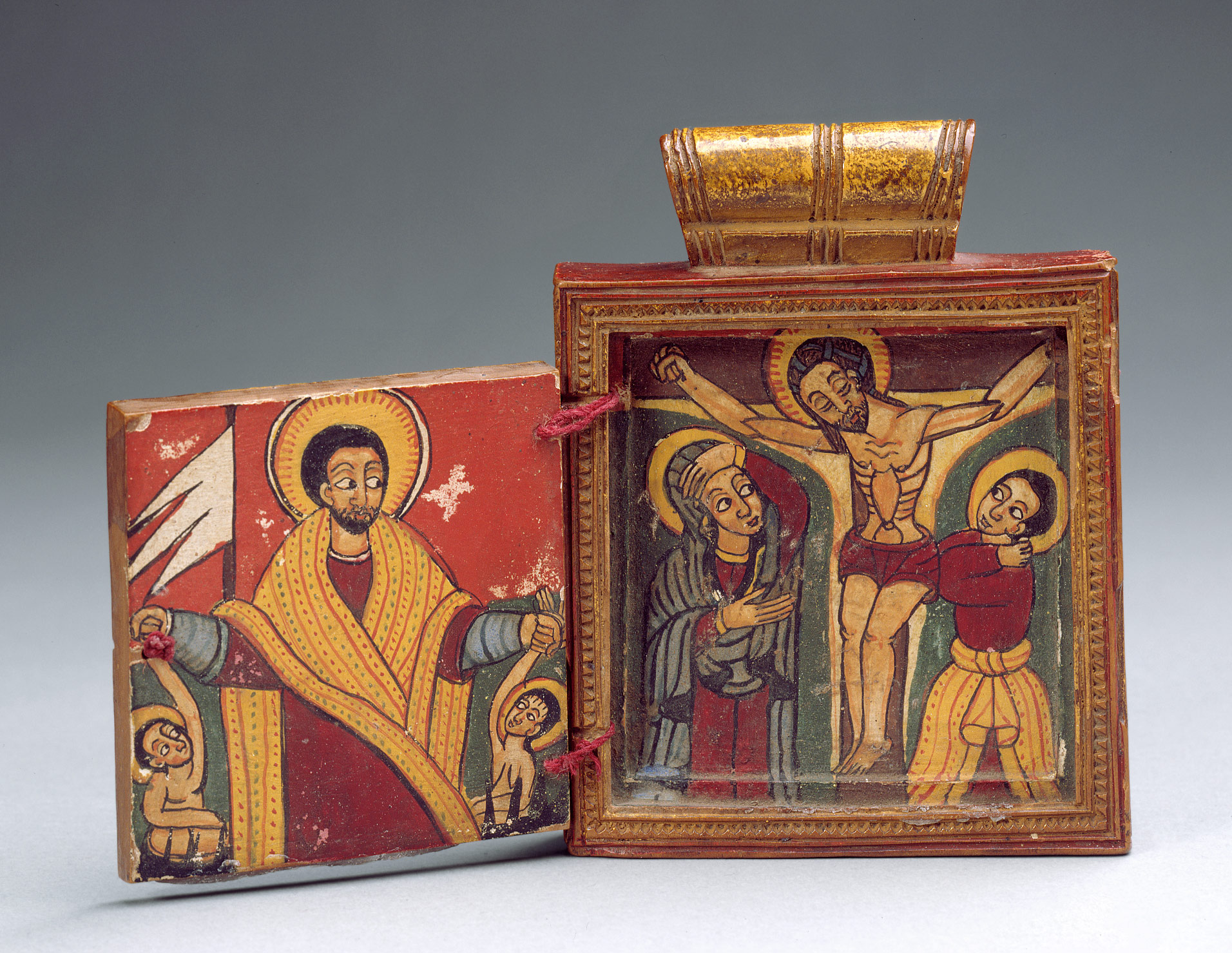
Pendant Icon, 17th–18th century
Ethiopia; Amharic
Wood, tempera paint; H. 3 3/4 in. (9.53 cm), W. 2 3/4 in. (6.96 cm)
Rogers Fund, 1997 (1997.81.1)
Inthe seventeenth century, Ethiopian artists were increasingly exposed toforms of expression from Europe. During this period, double-sideddiptychs became popular among the nobility as pendant icons wornsuspended by a cord around the neck. The subject matter depicted onthis example is a standard program for this genre of personal icon, asare the intricately carved cruciform designs that enhance the exteriorsurfaces of the protective covers.
This icon is a classic example of the painting style developedduring the late seventeenth century at Gondar, the trading center whereKing Fasiladas (r. 1632–67) established his capital. Portrayedfrontally with slightly turned heads and simple, iconic gestures, thefigures are superimposed upon neutral backgrounds. Bodies aredelineated with thick black outlines, while faces are composed of flatareas of pink and orange. Curving lines and attenuated arcs areemployed to evoke the folds of draped robes and mantles.
The double-sided pendant contains four painted surfaces depictingChristian subject matter. On one side of the main panel, the VirginMary appears seated, holding Christ and flanked by archangels carryingswords. Grasping the Book of the Gospel and making a gesture ofbenediction, the Christ Child gazes lovingly at his mother, who in turnstares out toward the viewer. On the outer panel (the interior surfaceof the cover), Saint George appears on horseback slaying the dragon.This combination of saints was extremely popular in Ethiopian religiouspainting, and served to emphasize the close relationship between theVirgin Mary and Saint George, the soldier of God who was her constantcompanion. The opposite side of the icon illustrates the Crucifixion,with Mary and Saint John standing sorrowfully to either side of Christ.The outer panel illustrates the Resurrection, in which a monumentalChrist raises the diminutive figures of Adam and Eve by their arms. Aflag of victory to Christ's right indicates this triumph over death.
在17世紀,埃塞俄比亞藝術家們越來越暴露的表現形式來自歐洲。在此期間,雙面diptychs成為很受群眾的貴族作為吊墜圖標破舊暫停由脊髓周圍的脖子上。此事描繪對這個例子,是一個標準程序,為這一體裁的個人圖標,是一脈刻十字型設計,提高外表面的保護範圍。
這個圖標是一個典型的例子的繪畫風格,在開發後期, 17世紀在gondar ,營運中心,國王fasiladas ( r.1632年至1667年)建立了他的資本。描繪正面略轉向元首和簡單的,標誌性的手勢,這些數字疊加後,中性的背景。機構圈定著厚厚的黑色的輪廓,而面臨的組成單位,地區的粉紅和橙色。彎曲線和衰減弧線受聘沉靜倍披上長袍和套。
該雙面吊墜包含四個畫面描繪基督教此事。一方的主體小組,聖母瑪利亞看來坐下,控股基督和兩旁archangels攜帶刀劍。抓住了這本書的福音,並作出一種姿態的功德,基督兒童目光愛戀,在他的母親,她又stares出面向觀眾。關於外板(內部表面的封面),聖佐治出現在馬背上殺害龍。這一組合的聖人是極受歡迎,在埃塞俄比亞的宗教繪畫,並以強調親密關係的聖母瑪利亞及聖佐治,該士兵上帝的人,是她不斷的同伴。對岸的圖示說明,在十字架上,瑪麗和聖約翰sorrowfully站在任何一方的基督。外層小組說明復活的,其中一項重大基督提高了微小的數字,亞當和夏娃是由他們的武器。掛旗的勝利,以基督的權利,表明這是戰勝死亡。 |
|
|
|
|
|
|
|
|
|
|
|
 发表于 3-11-2007 03:20 PM
|
显示全部楼层
发表于 3-11-2007 03:20 PM
|
显示全部楼层
|
|
|
|
|
|
|
|
|
|
|

楼主 |
发表于 4-11-2007 03:30 PM
|
显示全部楼层
回复 #48 基督教女圣徒 的帖子
见证???哪里是见证???
是艺术啦。。。不过你不反对吗?
好像有"偶像"也 |
|
|
|
|
|
|
|
|
|
|
|

楼主 |
发表于 11-11-2007 01:48 AM
|
显示全部楼层
大家如果有更多的兴趣可以去 http://www.metmuseum.org 寻找~
通常有说一些历史的。。。
例如
http://www.metmuseum.org/toah/ht/07/eusi/ht07eusi.htm
我之后不贴了~好累 @_@ |
|
|
|
|
|
|
|
|
|
|
|

楼主 |
发表于 4-12-2007 01:47 AM
|
显示全部楼层

Life is fragile image from The Great American Book of Church Signs by Donald Seitz

This sign was seen by Stephen Morris in Victoria, Bristish Columbia


An anti-church sign sent in by John Ballard

Sign sent in by Terence Harrington

Beth Stiller saw this sign on the Old Road to New Orleans in Mississippi, USAold road to new orleans

John Michael - Excuse Me. The photo was taken in Farmington, NewMexico. It is located just by Farmington airport terminal in the deepSouth West. John entered the image for selection into The RoyalPhotographic Society's 150th International Print Exhibition and it waschosen as one of 125 to be exhibited from over 2,200 entries. It isfrom a new book by the Society, called Portfolio One

Sent in by Jerry HarnishTaken in University Place (near Tacoma, WA, USA).

We need to talk image from The Great American Book of Church Signs by Donald Seitz

Don't give up image from The Great American Book of Church Signs by Donald Seitz

Church sign sent in by Jerry Harnishseen in University Place ( Tacoma, WA, USA).

Dutch Reformed Church in Springbok, North West South Africa.Taken by Billy Fletcher.Translation from the Afrikaans is "There is just one way"

Keep your words sweet image from The Great American Book of Church Signs by Donald Seitz

This too will pass image from The Great American Book of Church Signs by Donald Seitz

Tithe if you image from The Great American Book of Church Signs by Donald Seitz

WalMart image from The Great American Book of Church Signs by Donald Seitz

Cover The Great American Book of church signs by Donald Seitz

A sign sent in by David Whitfield
|
|
|
|
|
|
|
|
|
|
|
|
 发表于 4-12-2007 11:27 AM
|
显示全部楼层
发表于 4-12-2007 11:27 AM
|
显示全部楼层
回复 #51 daimon 的帖子
staying in bed那句最好笑。 |
|
|
|
|
|
|
|
|
|
|
|

楼主 |
发表于 4-12-2007 04:44 PM
|
显示全部楼层
回复 #52 ubiquitous 的帖子
不明白他想表达什么 |
|
|
|
|
|
|
|
|
|
|
|
 发表于 4-12-2007 07:51 PM
|
显示全部楼层
发表于 4-12-2007 07:51 PM
|
显示全部楼层
爆笑!!
"WALMART IS NOT THE ONLY SAVING PLACE"
经典啊! |
|
|
|
|
|
|
|
|
|
|
|
 发表于 5-12-2007 11:02 AM
|
显示全部楼层
发表于 5-12-2007 11:02 AM
|
显示全部楼层
回复 #53 daimon 的帖子
那我只能说:you lack the sense of humor |
|
|
|
|
|
|
|
|
|
| |
 本周最热论坛帖子 本周最热论坛帖子
|